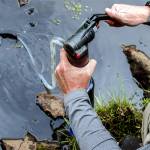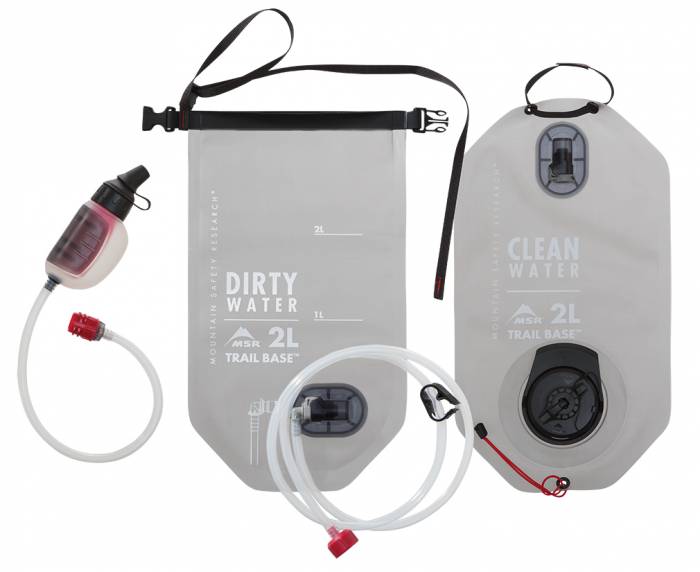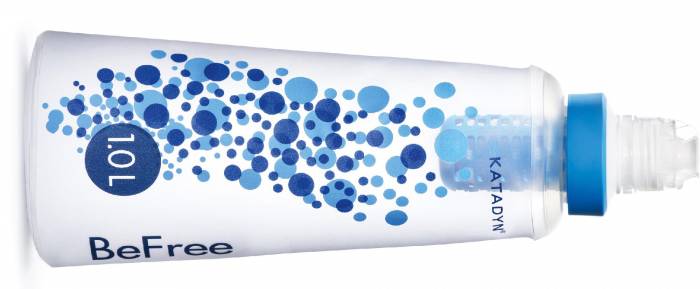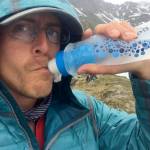From lightweight chemical purifiers to fast-acting pumps and large-quantity gravity filters, we’ve rounded up the best water filters and purifiers for the backcountry and beyond.
That pristine mountain stream can look entirely safe. But drinking untreated water is dangerous, which is why it’s important to have the right water filter or purifier.
In the backcountry, hikers, campers, hunters, and anglers need plenty of water each day. When you’re thirsty, it’s tempting to drink directly from a clear mountain stream. But it’s what we can’t see that harms us.
Living in those cool flowing rivers are viruses, bacteria, and parasites. These nasties quickly turn an adventure of a lifetime into an agonizing experience (for a full rundown of the risks, visit www.cdc.gov). Thankfully, we have several water treatment options — from inexpensive to high-tech.
Water Treatment: How to Choose
Your preferred water treatment may be based on price, ease of use, speed, weight, and water source, but there are other factors too. And depending on your budget, trip type (backpacking versus vehicle-based), and group size, one or more of these water treatment methods will best suit your needs.
This article focuses on the backpacker, hunter, or angler who is away from a domestic water faucet.
Water Treatment: Filtering vs. Purification
Water filters strain out the larger waterborne pathogens. Let’s geek out and talk like a microbiologist for a minute. Protozoan cysts such as Cryptosporidium (“Crypto”) and Giardia lamblia (“beaver fever”) and harmful bacteria such as E. coli, Salmonella, Campylobacter, and Shigella are easy to filter out because of their large size.
But viruses aren’t so easy because they’re tiny. Microscopic pores in the cartridge filter water through. The pores trap the protozoa and bacteria as well as silt and debris. Over time, the pores clog and require cleaning. Depending on the filter, plan to replace the cartridges every 1,500 to 50,000 L.
Water purifiers kill viruses, which are too small for filters to remove. Viruses such as hepatitis A, rotavirus, and norovirus are more of a concern in less-developed areas of the world. Purifiers use chemicals or ultraviolet light to kill viruses and other pathogens.
Iodine or chlorine tablets are the old-school way of getting safe drinking water. In high enough concentrations, purification tablets also kill most other pathogens too — Cryptosporidium cysts are some of the toughest to kill.
To remove unpleasant tastes from the water and to reduce pesticides and other industrial chemicals (in agricultural or developed areas), some filters and purifiers use activated carbon. Play it safe by avoiding toxic water sources that contain pesticide runoff, mine tailings, or other potential hazards. Boiling, filtering, or chemically treating water removes or kills microorganisms but will not remove chemical toxins. Distilling water removes toxins, but that’s too complicated to do in the backcountry.
If it comes down to it, a stranded hiker can make a solar still using a sheet of plastic to collect clean water from the air. But let’s hope it doesn’t come to that.
Boiling
Boiling is the best one-step way of killing all microorganisms. If a community’s water source is compromised, boil-water advisories are issued.
According to the Wilderness Medical Society, water temperatures above 160 degrees F (70 degrees C) kill all pathogens within 30 minutes, and temps above 185 degrees F (85 degrees C) do the same in just a few minutes. In theory, all pathogens are killed in the time it takes for the water to reach its boiling point (212 degrees F or 100 degrees C at sea level).
The CDC recommends a rolling boil for one minute to kill even the toughest Cryptosporidium oocysts. At higher elevations, water boils at a lower temperature. Above 6,500 feet, it’s wise to keep water at a rolling boil for three minutes.
Chemical Water Treatment
There are two main types of chemical treatment: iodine and chlorine. There are a variety of products on the market, so follow the directions on the bottle. Be advised that many of the tablets have an expiration date and may become less effective after that point.
Also, once the bottle has been opened, the tablets must be used within a certain period. Depending on the water temperature, chemical purification methods may not kill all pathogens. Boil water or use a combination of filtering and chemical treatment to kill all pathogens.
Caution: If you’re with a group, make sure there are no iodine allergies before using iodine tablets.
Aquatabs (30 tablets): $7

Aquatabs are a dissolving, chlorine-based, iodine-free water treatment that works within 30 minutes. Like treated domestic water, long-term use of these tablets has no adverse effects. They are safe for children and adults (including pregnant women). Chlorine kills “beaver fever” protozoa, bacteria, and viruses. But Cryptosporidium oocysts are resistant to chlorine and may not die if chlorine concentrations are too low or the water is too cool.
Each package contains 30 tablets. With clear water, each tablet treats 20 L. Add tablets to water 30 minutes before use. They have no odor or color, so they won’t stain or flavor your water bottle.
This product is approved and used by international aid agencies including NATO, UNICEF, and International Red Cross — with their stamp of approval, it must be an effective water treatment.
Potable Aqua Iodine and Taste-Neutralizer Tablets (50 tablets): $12.99
Iodine tablets kill biological pathogens, making most water in the backcountry safe to drink. Paired with a neutralizing tablet, little taste, odor, and color remains after treatment. Each bottle of Potable Aqua includes 50 tablets — two tablets treat 1 L of water, or 25 L per bottle. For a backcountry trip, you’ll need to calculate the amount of water needed per day and take enough tablets. If you’ll need 3 L per day, a bottle of tablets provides seven to eight days of safe water.
Potable Aqua tablets take time to kill pathogens: You must wait at least 30 minutes before drinking the treated water. Unopened bottles of Potable Aqua tablets are effective for up to four years when maintained under controlled temperatures between 60 and 86 degrees F. You shouldn’t keep an opened bottle of Potable Aqua for more than one year.
Caution: Iodine tablets are not effective against Cryptosporidium. Potable Aqua chlorine dioxide tablets (sold separately) kill Cryptosporidium.
UV Water Purification
These pen-style devices are quick and easy to use. Simply turn on, stick in your water bottle, and stir. It’s done when the UV light turns off (generally around 60 seconds).
Be forewarned, though, that dirty, non-clear water can inhibit effectiveness. And it’s not a great option for purifying large quantities of water. But for anyone looking for a packable and simple device, these can be great.
SteriPEN Adventurer Opti UV Water Purifier: $99.95
Shortwave ultraviolet light is one method used to disinfect water. To use, immerse the SteriPEN’s lamp in the water and stir. The UV radiation disrupts the DNA of bacteria, viruses, and protozoa, rendering them “sterile” and unable to reproduce. SteriPEN works in containers with openings as small as 1.75 inches. It’s a slower process than other methods — treatment of 1 L of water takes about 90 seconds.
To kill all pathogens, prefilter the water first to clear particulates and debris. Pathogens can “hide” from the UV in cloudy water. Any time you expect to encounter muddy or silty water sources, either prefilter or consider an alternate purification system.
The SteriPEN’s lamp life lasts for about 8,000 treatments. A downside to a UV treatment light is it requires batteries — and not AA’s. To operate in cold environments, the SteriPEN Adventurer uses two CR123 batteries. As with all battery-powered devices, it’s a good idea to pack spare batteries.
Pump Water Filters
Place the intake hose directly in the source of water and begin pumping. Pump filters are straightforward but not without their downsides: mainly, weight and effort. It can be a tiring hassle to pump water, especially toward the end of the filter’s life.
MSR MiniWorks EX Microfilter: $89.99

The MiniWorks EX microfilter is a popular water filter among backcountry travelers. It’s relatively light at 1 pound and uses a carbon/ceramic filter element. The ceramic element filters the water while the carbon removes unpleasant tastes. The filter is capable of pumping 1 L per minute. Although the pump handle is easy to use, the repetitive motion is tiring. If you’re pumping a 10-L bladder for a group, you’ll need to take a few breaks to rest. If the flow drops off, clean the filter. And tools aren’t necessary for cleaning in the field.
This filter was made for use in freezing temperatures. According to MSR, if you anticipate the filter will freeze, make sure to drain the filter of excess water to protect it from damage. If the filter does freeze, bring it inside the tent or another warm place to thaw, or follow the directions for boiling the cartridge.
MSR Guardian Purifier: $350
This medical-grade filter packs a major punch. It can clean 2.5 L in just 60 seconds and gets rid of all the nasties — including viruses. At $350, it’s by far the most expensive on our list, but it’s both a filter and a purifier. On top of that, it’s self-cleaning. With each pump, the Guardian uses 10 percent of the water to flush contaminants back into the source. And it can freeze too.
At 17 ounces, it’s not super light, and it will take up about as much space in your pack as a 1-L bottle. But depending on your situation, it could be well worth the price and space to have a single pump to both filter and purify your water.
Gravity Water Filters
Gravity systems are about as simple and low-effort as they come. Just fill your bag, hang up high, and watch the water filter. These are a particularly great option for groups, as you can easily filter large quantities of water in a fairly quick fashion (though slower than most pumps).
Platypus GravityWorks 4-L Water Filter System: $119.95
Gravity systems take the work out of filtering water. Simply fill the 4-L “dirty water” reservoir and let gravity do the hard work. With a clean filter, a flow rate of 1.75 L per minute is possible. You can backflush the microfilter in about four seconds to maintain filter performance. The filter element is relatively small, so it’ll need replacement every 1,500 L of water filtered. It’s compact and weighs less than 1 pound.
The filter uses hundreds of tiny, hollow fibers, enabling the microfilter to filter water faster than traditional filter media. The downside to this type of filter is that freezing will wreck it.
Katadyn BeFree 3-L Gravity Filter: $55
The Katadyn BeFree 3-L gravity filter is easy to clean: Just shake or swish the water around the filter. That sets it apart from many systems that require back-flushing. It’s also very light and compact at just 4 ounces for the entire system.
To use it, just hang the reservoir from a tree or other object. Then, let gravity do the work. The system’s 0.1-micron microfilter is tested to remove 99.99 percent of protozoa and 99.9999 percent of bacteria to EPA standards.
It filters 3 L in about two minutes. We’ve used this one to great success and think it’s a great value at $55. Check out our full review here.
MSR Trail Base Water Filter Kit: $139.95
This could be the best deal on the water filter market right now. For $140, you get a gravity system for base camp, a pocket-sized filter for the trail (the Trailshot), and a hydration reservoir for carrying water with you. There are a lot of products that excel in one of these areas, but the Trail Base does it all. At 1 pound 6 ounces, it’s not super light, but it’s convenient enough to easily backpack into any wilderness area — especially considering its multitude of uses.
Straw and Squeeze Filters
For a quick drink while hiking or packable backup filter, straw and squeeze filters are ideal. They don’t take up much space and are easy to use.
LifeStraw Personal Water Filter: $19.95
Personal filters are perfect for a quick drink on the trail or if you don’t need to filter large volumes of water for personal consumption. This water filter works like a drinking straw. To use, suck water through the straw directly from the source. Don’t plan on gathering enough water to make dinner.
It’s light (2 ounces or 57 g) and only 9 inches long. The straw-style filter design lets you turn up to 4,000 L of contaminated water into safe drinking water.
If there’s a downside, to use the LifeStraw, you’ll need to get close to the water. This means down on your belly by the stream. If you’re okay with that or have the means to stay dry, this device is a lifesaver.
Katadyn BeFree Collapsible Water Filter Bottle: $44.95
This ultrapackable bottle gives you the freedom to drink anywhere. Simply dip into the water source, screw on the cap, and drink. It filters out 99.99 percent of bacteria and protozoa, which is adequate for most wilderness areas. If the filter seems clogged, it just takes a quick shake to get it flowing again.
We like that it packs down small like the straw filter, but instead of only being able to drink at the source, you have the added benefit of carrying some water. This isn’t a great option for large groups or long distances away from water, but for individuals near a water source, it’s a solid option.
Good to the Last Drop
Even with safeguards in place, it’s wise to take some first aid for ingesting bad water — such as Imodium. If you do contract a gastrointestinal bug despite your precautions, Imodium will allow you to get out of your favorite middle-of-nowhere.
The post Best Backcountry Water Filters and Purifiers: Drink Up Safely appeared first on GearJunkie.
from GearJunkie https://ift.tt/2DwTJYG
https://ift.tt/2RNxjFW














No comments:
Post a Comment